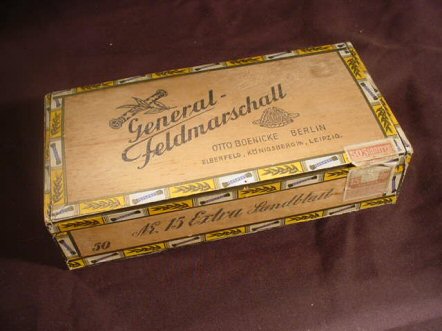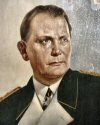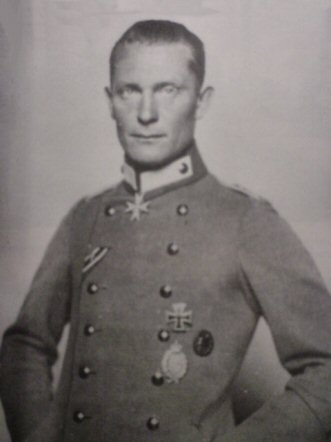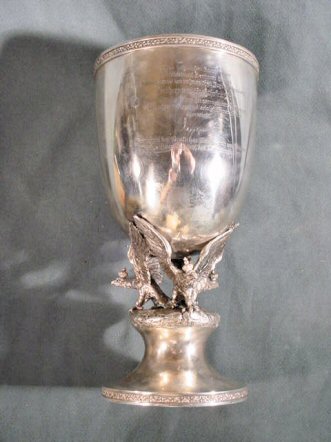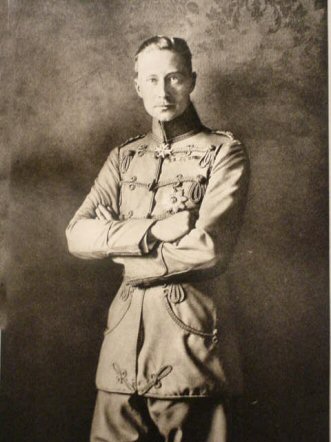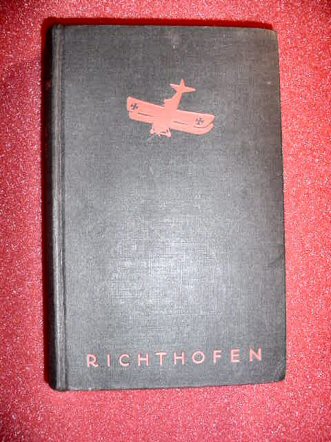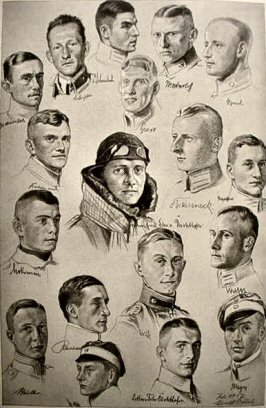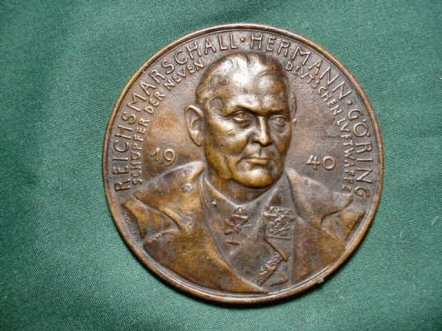|
|
|
|
Hermann Göring
Page 6
|
|
|
|
|||||||||||||||||||||||||||||||
|
Göring Complete Dinner Service for One by KPM (Item GOR 6-1) |
|||||||||||||||||||||||||||||||
| DESCRIPTION: This is an incredible ensemble form Carinhalle, Göring’s fabulous lodge in east Prussia. These 13 pieces of the finest table setting fit for a king or, rather, a Reichsmarschal consists of: 1. A 10-inch dinner plate 2. A 9 ½-inch soup bowl 3. An 8-inch sandwich plate 4. A 6 ¾-inch dessert plate 5. A 5-inch tea saucer 6. A 3-inch demitasse cup 7. A fantastic crystal goblet 8. One large soup spoon 9. One large dinner fork 10. One table knife 11. One dessert or luncheon fork 12. One luncheon spoon or sugar spoon 13. One luncheon knife Göring always had the very finest and this set is no exception. In fact, it is the best of the best! The dishes are all with hunting motif (Göring was officially the master of the German hunt). Carinhalle, named after Göring’s beloved first wife was, in fact, a hunting lodge; although fitted out as an elegant palace. The scenes are of hunters, hunting dogs, and game animals. The bowl has an 18th century hunt scene in mirthful hunting formation. The service was by “KPM.” The Berlin porcelain was produced by the firm know as the King’s Royal Porcelain Manufacturer, Königliche Porzellan Manufaktur Berlin, the finest since the 18th century; even finer than Meissen. This is the crème de la crème of European porcelain. Signed pieces like this from the 1930’s are highly sought after and very rare. The flatware is also the very finest. It is by Puiforcat of Paris. The French silversmith Jean E. Puiforcat ranks among the greatest of the 20th-century designers. He began his illustrious career in 1920 after years of apprenticeship by his father, Louis Victor, 1867-1955. He exhibited at many of the finest galleries worldwide. there are lengthy articles about this master designer all over the web. You will see that signed pieces are much in demand and command very high prices when rarely found. The goblet (the most supreme item) of the ensemble is most likely Bacharach crystal. It is Göring for sure. It bears his coat of arms supported by palm-leaf design in the most delicate cut-glass style with gold-leaf rim design. This is incredibly all hand cut by an absolute master artisan. On the other side is the final touch so “Goringesque” that only this renaissance man would be so culturally inspired to employ it. Behold an oriental snake charmer playing the flute with serpents on each side moving through the jungle greenery. The highly decorated goblet is 4 ¾ inches high with a mouth opening of 2 ¾ inches diameter. The square and unique bottom pedestal is 2 ½ inches square. Needless to say that this is absolutely without a doubt the epitome of the glass-designer craft. We have specialized in Hermann Göring’s magnificent items procured through a special source, but for unique and vastly historic importance this has to be the ultimate zenith in its completeness and beauty. This is a wonderful opportunity to own and enjoy this former property of this magnificent historical latter-day Falstaf; a proud, brave, but sad figure of world history-admirable, but tragic. To the German people he still remains Unser Hermann. PRICE: SOLD |
|
||||||
|
Göring Cigar Box (Item GOR 6-2) |
||||||
| DESCRIPTION: Here is a great Hermann Göring item in the form of a cigar box from Otto Boenicke Manufacturing and Tobacconist with offices in Berlin, Elberfeld, Königsberg, and Leipzig. It was pretty much a well-know fact that H. Göring owned the greatest shares of this prosperous company. This particular brand of cigars was named the "General Feldmarschall" and the Marschall batons were the logo that were displayed wherever these fine cigars were featured. You can see them all along the edges of the box. Notice also the tax stamp with eagle and swastika and the listed price of 15 Reichspfennig per cigar. When the box is opened the portrait of the General Feldmarschall with a facsimile of his signature is shown. Airplanes of Germany's Luftwaffe fly overhead. Göring was a real cigar aficionado usually preferring Cuban imports, himself. This box is really a very rare trophy of war because of its rather fragile makeup; however, it's in very fine condition, considering. It measures 9 ¼ x 4 ½ inches and is 2 ¼ inches deep. This original 1930's box is quite decorative as well as historically important and would make a great addition to any Third Reich or Air War collection.
PRICE: SOLD |
|
||
|
Portrait on Wood of Hermann Göring (Item GOR 6-3) |
||
| DESCRIPTION: This is done in the decoupage style of the Reichsmarschal Hermann Wilhelm Göring. This is quite a beautiful portrayal of Unser Hermann. He is shown in his marshal’s uniform with Pour le Mérite (Blue Max). This looks and feels like marquetry, but we feel it is applied impression. It has been framed very professionally in a deep frame specially fitted. This is no mere print. It is a representative piece from a Third Reich exclusive art form. In the frame it measures 14 ½ x 18 inches and its special birch-wood-looking original edging. This is a very fine and dramatic depiction of Germany’s second most important leader of the 1930’s and 1940’s and to the German people, the most beloved.
PRICE: $595.00 |
|
|||||||||||||||||||||||||||||
|
Hermann Göring Goblet (Item GOR 6-4) |
|||||||||||||||||||||||||||||
| DESCRIPTION: It’s hard to even summon up our feelings about the importance and fantastic beauty of this offering. For years now, Germania International, LLC has procured and offered the best and the most rare of Germanic antiquities and prodigiously important relics of interest to pure Germanophiles. Now, because of a very valuable contact in the Fatherland, we have managed to purchase a magnificent goblet that practically defies the imagination and even our expectation in this most fascinating field. This piece embodies the glory and noble aspirations of two of the world’s most important personages, Hermann Wilhelm Göring, and the Crown Prince of Prussia, Wilhelm III, son of Kaiser Wilhelm II, Emperor of all Germany. This is the very goblet presented to Hermann Göring as the last commander of the German Fighter Squadron “Freiherr von Richthofen Nr. 1.” (The Flying Circus). The presentation words are: “Dem Siegreichen Kampfflieger Oberleutnant Hermann Göring Kommandeur des ruhmreichen Jagdgeschwaders “Freiherr von Richthofen Nr. 1” als Anerkennung seiner hervorragenden Leistungen als wagemutiger und erfolgsicherer Führer überreicht (Wilhelm signature). Kronprinz des Deutschen Reiches und von Preussen Grosses Hauptquartier, den 2 September 1918. Translation: “To the victorious war flyer lst. Lt. Hermann Göring, the commander of the glorious fighter squadron Baron von Richthoffen No. 1 in acknowledgement of his excellent achievement as its brave and successful leader.” Then Wilhelm lends his signature and under this: “Crown Prince of the German Empire and of Prussia at the Great Headquarters on September 2, 1918.” The Prussian crown prince was born 6 May 1882 and died 20 July 1951. He was born to the Hohenzollern dynasty at Potsdam. He was the oldest son of Kaiser Wilhelm II, 1859-1941. In WWI , he was placed in charge of the 5th Army and he served with distinction as a front-line officer always looking very dashing in his jaunty Hussar uniform of the Leib Hussar Regiment, which, of course, was part of the 5th. After the disastrous abolition of the German monarchy in 1918, he was forced into abdicating and joining his father, the Kaiser, when they went into exile in Doorn, Netherlands. The ex-prince returned to the Fatherland in 1923. He ultimately publicly endorsed Adolf Hitler and the NSDAP, but unlike his younger brother, he did not join the party. Hermann Wilhelm Göring, 12 January 1893-15 October 1946. Göring was commissioned a second lieutenant in 1912 and assigned to Alsace where he formed a cyclist corps. In 1915, his friend, Bruno Loerzer, persuaded him to join the Air Corps. He essentially deserted his infantry unit and assumed the role of Loerzer’s observer. He and Loerzer both won the Iron Cross First Class for their reconnaissance work. He flew with Loerzer until the spring of 1916, when he went to pilot-training school at Courtral. Göring already knew how to fly and “borrowed” a Rumpler that he flew to the front. In short order he was assigned to a fighter staff near Verdun. Göring’s unit was Staffel 5 flying Fokker E111 Eindeckers with his friend, Bruno. By the end of 1916, he was credited with three French airplanes and with saving Bruno’s life. When Loerzer’s machine gun wouldn’t fire two Nieuports pounced on him. Göring saw this and drove off both Frenchmen, destroying one of their aircraft. In mid-February, 1917, he got separated from his flight one day and went after a twin-engine biplane. After he knocked out one of its engines, a flight of Spads showed up and attacked. He fought them for fifteen minutes as he flew all out for the German lines. The Spads shot up him and his aircraft quite badly, but he managed to land near a field hospital, where prompt treatment probably saved his life. Fortunately, he survived, and returned to action in a couple of months. In May, Loerzer reciprocated and saved Göring one day when his propeller was shot away; Loerzer covered him until he could land at an advance airfield. By the end of May, Göring had accumulated seven aerial victories. Jasta 27 In June, 1917, Göring was given command of Jagdstaffel 27, a unit made of new graduates of flying school. Within a few days of joining Jasta 27, Göring was leading a flight of ten planes over Arras when they encountered a group of British Nieuports. Göring dived after one Nieuport and soon found himself in trouble as the Nieuport began to shoot him up. But he got in a lucky burst and the Englishman went down on the German side. A week later Göring scored his tenth kill when he met some FE's and Camels above Cambrai. After destroying an FE, another flight of Sopwiths came on and shot down one of his Albatroses. Göring knocked down another one of the Camels before even more arrived, at which point he led his Albatroses home. By the end of 1917, he had sixteen claims. Göring started the year 1918 on a near-disastrous note, when the gunner in a British F.E.2b riddled his fuel tank and sent him spinning earthwards. Some other Albatroses from his squadron saved him again. He had another close encounter in February when Lt. W.B. Craig, a five-victory Sopwith pilot, shot up Göring's Albatros. Once again, dependence on skill seemed to be with Göring, and he shot down Craig. By June he had run his score to 21, and won the coveted.Ordre pour le Mérite. On 21 April 1918, Baron Manfred von Richthofen was shot down an killed near the Somme River. He, the ace of aces (Red Baron) would be hard to replace, but Hermann Göring was appointed head of the Richthofen Group in July, much to the annoyance of many aces in that group with 40+ kills. But Göring turned out to be a good group leader and the complaints faded away and morale improved. He shot down one more Spad for his 22nd and final victory. The respected historian and author, Norma Franks, noted that many of Göring’s kills seem to have occurred over British lines. When the war ended, J.G. Richthofen was ordered to Darmstadt. When the group arrived there, the city was in the hands of revolutionaries, who captured some of the planes' weapons. Göring faced down the rebels, threatening to bomb and strafe the town if the arms were not returned. The revolutionaries complied. In the 1920's Göring went to Sweden and flew for an air transport company. He met Adolf Hitler and became a leader of the Nazi Party in the 1930's. He became the second most powerful man in the Third Reich and Hitler's heir apparent, Minister of Aviation, and head of the Luftwaffe. Condemned to death at the Nuremburg trials, he cheated the hangman by swallowing cyanide. The goblet is a masterful accomplishment of a skilled silversmith and it, of course, bears the compulsory German silver acceptance marks. It is a huge silver art piece measuring over 14 inches high. It is wonderfully chased and the engraved presentation is certainly worthy of a “Kaiserprize!” and that is essentially what we have here. It is the royal recognition of the valiant commander of Germany’s greatest fighting unit of the air war. The die was cast at this point and the prince probably knew that the war could not be won, but the Prussian spirit of glorious military respect just had to be demonstrated this one last time in honoring this great warrior of the skies. The Pokal is in the finest of 800 silver. The mouth opening is 7 ½ inches in diameter. The bottom of the base is 6 inches across. Standing on top of a plinth that looks like live, trampled ground are three Imperial eagles wearing the Prussian crown and their wings act as support for the bowl of the vessel. The eagles are very similar to the ones used on a helmet of the Imperial Garde du Corps, the bodyguard regiment to the Hohenzollern, Kaiser, and family. The top and bottom edges bear an intricate floral design. The condition is near perfect with one minute dent just before the words “in anerkennung.” It is hard to imagine a finer or more historically important piece of World War One memorabilia with its importance also stretching to World War Two. The enthusiast of early aviation, the collector of Göring-related items, or the investor who collects only the absolute finest of military-inspired art will probably agree that this without doubt is a spectacular find extraordinaire! PRICE: SOLD |
|
||||||||||||
|
Book Der Rote Kampfflieger, The Red War Flyer (Item GOR 6-5; LUFT 10-6; WWI 6-17) |
||||||||||||
| DESCRIPTION: This is a book chronicling the life, adventures, and death of the great air hero, Manfred von Richthofen, known to the English-speaking world as the “Red Baron” and to the Germans as the “Red War Flyer.” The book comprises 262 pages with great pictures and a foreword by Hermann Göring, who, in 1933, when this book was published, was Reichsminister of the German Third Reich. There are about 70 pictures ranging from pictures of Manfred and fellow pilots, to air battles, wrecks, enemy aircraft, victories, etc. There is a moving picture of his funeral with Australian soldiers firing a salute in honor of a fallen adversary, who was greatly respected. The book is in very nice condition and certainly a valued addition to any good archival collection.
PRICE: Sold |
|
|||||||||
|
Göring Art Medal (Item GOR 6-6) |
|||||||||
| DESCRIPTION: This is one of the greatest art medals of the Third Reich--certainly the finest for detail and historic significance. The obverse depicts in fine bronze a bust portrait of Hermann Göring dated 1940. Around the edge it states: “Reichsmarschall Hermann Göring Schöpfer der neun Deutschen Luftwaffe,” which translates to: “The creator of the new German Air Force.” On the reverse is depicted the young Hermann Göring seated in the cockpit of his Fokker aircraft behind the machine gun. Over this depiction is an arrow with “22” (the number of his WWI air victories) and around the top edge the words translated: “Last commander of the Fighter Squadron Richtoffen.” Under the portrait is a paragraph from his address to his flying troops translated: “Our way is dark, comrades, however, our loyalty truly we hold!” Under this legend is a small Pour le Mérite, the cherished Blue Max that Göring had won in aerial combat. The medal measures 2 ¼ inches in diameter. This is truly a handsome medallion or art medal with tremendous historic significance.
PRICE:$850.00 |
Contact Us |



































